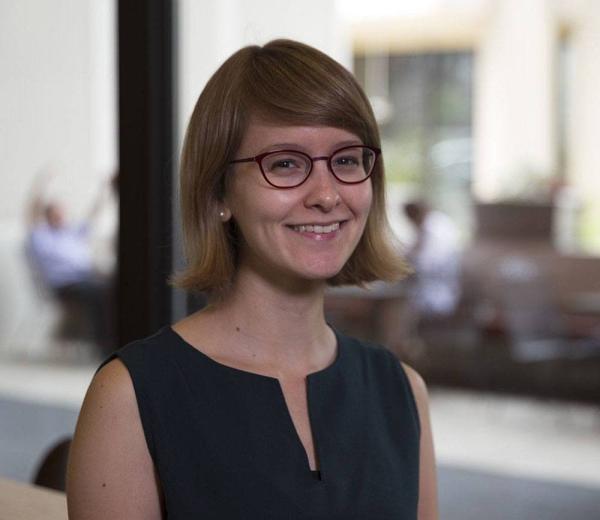Three-Minute Talks Pit Researchers Against the Clock
IRP Scientists Keep it Short and Sweet in Competition’s Final Round

In NIH’s Three-Minute Talks (TmT) competition, contestants had just three minutes to explain their research in a way that could be understood by an audience unfamiliar with their areas of expertise.
Science is so closely associated with long, jargon-laden lectures that scientists like Neil deGrasse Tyson and the IRP’s own Anthony Fauci have become celebrities for their ability to explain complex scientific concepts in a succinct and understandable way. On June 25, 17 postbacs, graduate students, and postdocs from across NIH showcased their own communication chops in the final round of the IRP’s annual Three-Minute Talks (TmT) competition.
Before presenting their talks in the competition finals, the speakers received tips from public speaking coach Scott Morgan, who also moderated the virtual event. Scott has worked as a science communications consultant with NIH for more than two decades, and his own background exemplifies the blend of skills required to describe complicated scientific research to a non-expert audience: he majored in theater as an undergraduate at the University of California at Davis and has a Master’s degree in clinical psychology. With his assistance, the TmT participants were able to convey the most important aspects of their work in less than three minutes each. As an added bonus, after each presentation, Scott quizzed the speaker about a fun factoid he had learned about them, providing some nice insights into what the researchers do outside of the lab.
Also lending their expertise to the final round of this year’s TmT competition was a panel of judges consisting of Harrison Wein, Ph.D., head of the Science Communications Branch in the NIH’s Office of the Director (OD); Virginia Meyer, Ph.D., the Training Coordinator at NIH’s National Library of Medicine (NLM); and Phillip Ryan, Ph.D., the Deputy Director of Graduate Programs and Students Services for the NIH Graduate Partnership Program (GPP). The judges were so impressed with this year’s cadre of speakers that they couldn’t narrow the field to just three winners.

IRP postdoctoral fellow Valerie Darcey took home top honors at this year’s TmT competition.
First place in the competition went to IRP postdoctoral fellow and registered dietician Valerie Darcey, who works in the lab of Kevin Hall, Ph.D., at the National Institute of Diabetes and Digestive and Kidney Diseases (NIDDK). Her presentation, cleverly titled, “Did dopamine derail your diet?” explained her research on how diets differing in their fat and carbohydrate content affect dopamine, a reward- and learning-related chemical, in the brain.
“I was in a state of joy and disbelief when they announced my name,” Valerie says. “It was a really competitive field. When I saw who the judges selected for second and third place, I was nervous because those presenters really did an outstanding job — I was glued to the screen during their talks!”
Her studies showed that a reduced-fat diet lowered the availability of receptors in the brain that respond to dopamine, reduced the brain’s response to pictures of food, and slightly increased consumption of high-sugar and high-fat foods among volunteers participating in an in-patient study. A reduced-carbohydrate diet, on the other hand, did not have any of these effects. Since dopamine receptors become less available when there are higher levels of dopamine in the brain, her results together suggest that reducing consumption of dietary fats may increase dopamine levels in the brain, which could in turn influence people’s desire for high-calorie foods.
Valerie also has personal experience with another factor that increases levels of dopamine in the brain: exercise. A seasoned marathon runner, she relayed her disappointment that she had qualified for last year’s Boston Marathon only to learn that it had been canceled as a precaution due to COVID-19. Nevertheless, she has not let that deter her from training for this year’s race in October. Meanwhile, her participation in the TmT competition has sparked a new interest in science communication.
“I think it’s partly due to my training as a dietician, but it turns out I really enjoy distilling science for wide consumption,” she says. “It’s tricky though because there is a lot of nuance and many caveats that don’t make the cut.”

IRP epidemiologist Susanna Mitro won second place for her talk on how uterine fibroids change over the course of pregnancy.
Susanna Mitro, an epidemiologist at the Eunice Kennedy Shriver National Institute of Child Health and Human Development (NICHD), earned second place based on her engaging presentation about how uterine fibroids, non-cancerous growths in the uterus, change over the course of pregnancy. While most expecting mothers experience no ill effects from fibroids, roughly 10 to 30 percent of women with fibroids develop some sort of pregnancy complication, such as a preterm delivery or the need for a C-section, making it important to understand how these growths behave in pregnant women. After her presentation, Susanna responded to a question from Scott about her love of bird-watching, describing her recent sighting of a large red-tailed hawk by the Capitol building in Washington, D.C.
Nicole Folan from the National Institute on Deafness and Other Communication Disorders (NIDCD) and Esther Sim from the National Center for Advancing Translational Sciences (NCATS) tied for third place. Nicole described her investigation of the biological pathways that protect the hair cells of the inner ear from the toxic side effects of some therapeutic drugs, while Esther discussed her lab’s development of a 3D tissue model for identifying novel cancer therapies. When they are not busy working with cells, Nicole likes to make vases and other gifts for family and friends using her glass-blowing talents, while Esther rocks the electric cello, which she describes as an extremely versatile instrument that allows her to “cross a lot of genres.”
The past year has made it clear just how essential effective science communication is for keeping the public healthy and safe. Fortunately, NIH’s Three-Minute Talks competition is just one of many programs at academic institutions around the world that help scientists improve their communication skills. By venturing out of the ivory tower and connecting with non-scientists, researchers can help create a society in which their work is not just better-understood, but also appropriately valued for its potential to improve health and save lives.
Subscribe to our weekly newsletter to stay up-to-date on the latest breakthroughs in the NIH Intramural Research Program.
Related Blog Posts
This page was last updated on Monday, April 21, 2025
